#sarah cascone
Explore tagged Tumblr posts
Text

Artist Jonathan Harris and his painting titled “Critical Race Theory"
It’s a hauntingly effective image. A blonde figure stands, back to the viewer and paint roller in hand, covering up the images of Martin Luther King Jr., Harriet Tubman, and Malcolm X with strokes of white paint. Critical Race Theory (2021) has been embraced as a powerful reminder of the importance of teaching and preserving Black history.
The canvas is the work of Detroit artist Jonathan Harris, who, since taking up painting full time nearly four years ago, has dedicated himself to making work expressing his lived experience as a Black man in the U.S. Critical race theory, which examines the ways in which racism is embedded in our nation’s legal systems and policies, has been circulating in academic circles since the 1970s. But it began making headlines, especially in conservative media, in 2022 as some local lawmakers sought to proactively ban its teaching.
#news.artnet.com#reddit#pics#aacool#sarah cascone#martin luther king jr#mlk#dr martin luther king jr#blm#critical race theory#history#american history#black history month#black history#read#art#harriet tubman#malcolm x#2021#2020s#painting#painter#artist#teaching bans#study history#us politics#jonathan harris#keep thinking#keep reading#don't allow others to control what you learn
182 notes
·
View notes
Text

Emily Sargent (USA, 1857 - 1929) copying an Old Master painting at the National Gallery, London (ca. 1930). Photo courtesy of R.Ormond.

Emily Sargent, Untitled (Tropical Seascape). Collection of the Sargent House Museum.
Read: Emily Sargent, Not Just a Sister to John, Was a Serious Painter in Her Own Right. Her Watercolor Landscapes are Finally Entering Museums—and the Spotlight
John Singer Sargent's family has donated never-before-seen work by Emily to seven museums.
Sarah Cascone | February 6, 2023
8 notes
·
View notes
Text

Chance Encounters #007
https://www.mixcloud.com/thomasmartinnutt/
Gordon Mumma, Vladislav Delay & Eyvind Aarset, Ben Frost, Alial Straa, Charles Olsen, Graham Lambkin & Áine O’Dwyer, Félicia Atkinson, Feronia Wennborg, Yama Yuki, Permanent Six Flags, Sarah Davarchi & Sean McCann, Angus Carlyle, Pierre Schaeffer & Pierre Henry, Charlie Morrow, AGF & Delay, Valentina Magaletti & Laila Sakimi, Geneva Skeet, Merzbow, Mats Gustafsson & Balazs Pandi, LFO, Michiko Hirayama, Eliane Radigue, Stephen Vitiello, Cia Rinne & Sebastian Eskilden, Felicity Mangan, Kim Cascone, Roméo Poirier, Francisco Lopez, Ganavya, Caroline Shaw & Attacca Quartet, The Australian Art Orchestra, Clara de Asis & Ryoko Akama, Paul Beaudoin
5 notes
·
View notes
Text
“Its ancient creators carved the work from a single larch tree with 159 growth rings..”
“The idol was carved during an era of great climate change, when early forests were spreading across a warmer late glacial to postglacial Eurasia,” Terberger tells Franz Lidz of the New York Times. “The landscape changed, and the art—figurative designs and naturalistic animals painted in caves and carved in rock—did, too, perhaps as a way to help people come to grips with the challenging environments they encountered.”
According to Sarah Cascone of Artnet News, the new findings indicate that the rare artwork predates Stonehenge, which was created around 5,000 years ago, by more than 7,000 years. It’s also twice as old as the Egyptian pyramids, which date to roughly 4,500 years ago.
As Artnet News reports, the complex symbols carved into the object’s wooden surface indicate that its creators made it as a work of “mobiliary art,” or portable art that carried ritual significance.
Source: Smithsonian Magazine March 25, 2021

The Shigir Sculpture is the oldest known wooden sculpture in the world, made during the Mesolithic period, shortly after the end of the last Ice Age. The wood it was carved from is around 11,500 years old..
Source
2K notes
·
View notes
Text
Getty Images is the the official photographic agency of the International Olympic Committee.
It’s the photographers who create the lasting images of the games, working tirelessly to capture every event.
Getty photographer Adam Pretty is a veteran of 12 Olympic Games.
Check out Adam's interview with Sarah Cascone (Senior Writer at ArtNet News) about the gruelling experience of shooting the 16-day event.
#Getty Images#photography#photographers#Olympics#Sports Photography#storyteling#Addicted Art Gallery#Interview
0 notes
Text
Marina Abramović’s First Show in China Features Crystal Shoes and Telepathy Phones
Abramović claims her new crystal-based works can help you learn to communicate remotely.

Marina Abramović in 2016. Photo by Reto Guntli.
Sarah Cascone August 5, 2024
Marina Abramović is about to have her first museum show in China, returning to the nation where the performance artist famously walked the Great Wall to dissolve her partnership with Ulay in 1988.
The exhibition, “Marina Abramović: Transforming Energy,” will open at the Modern Art Museum Shanghai (MAM) in October. But while the 77-year-old Abramović is well known for performing inside museum halls, she is asking visitors to take center stage this time around.
“It’s completely 100 percent interactive,” Abramović said in a virtual press event announcing the show. “I’ve never had a show like this in my entire life.”
“This is perhaps the first time that Marina is encouraging the audience to be the performers,” MAM artistic director Shai Baitel added. “She’s asking the audience, be present. Remove your phone. Be with us. Stay with us.”

Marina Abramović, Shoes for Departure (1991/2017). Courtesy of Sean Kelly Gallery.
It’s the artist’s largest show to date with 150 works, roughly 75 percent of which are being shown for the first time.
That includes “Transitory Objects,” sculptures collectively made from over 6,600 pounds of minerals that invite visitor participation. Abramović—who also touts the anti-aging properties of minerals in pricey skincare products—believes that crystals contain transformative energy.
“Hematite really raises your blood pressure; the rose quartz work on your heart; the clear quartz work on your mind; tourmaline on your liver. All of these things actually have also medical property, scientific property and energy property,” she said. “It is up to the public to discover them.”
The works are made from copper, iron, wood, and Brazilian crystals. By sitting or standing on or beneath the pieces, museumgoers are meant to channel the minerals’ energy. (Trained facilitators will tell visitors what to do.)
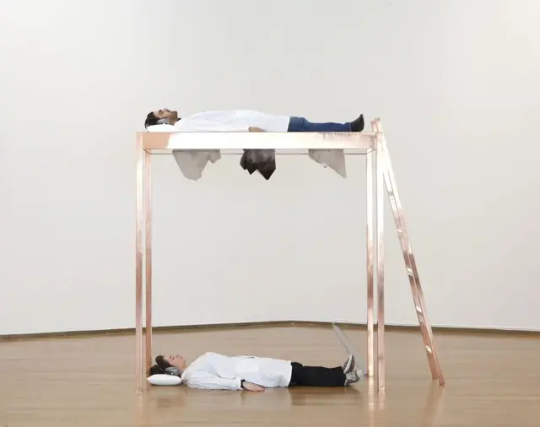
Marina Abramović, Copper Bed for Human Use (2012). Photo: Fabrizio Vatieri, courtesy of Sean Kelly Gallery.
“The audience can connect themselves and incorporate their physical being with the objects themselves,” Baitel said. “And they can improve themselves and enjoy the qualities and the goodness the minerals have to offer.”
“I’m using geodes 35 billion years old,” Abramović added. “You can sit on the little chair and look inside the geode like you’re looking inside the stomach of the planet.”
The artist cites her three-month walk across China, titled Great Wall Walk, China (1988) as an inspiration for the series, which draws on Tibetan and Chinese medicine, spiritualism, and healing.
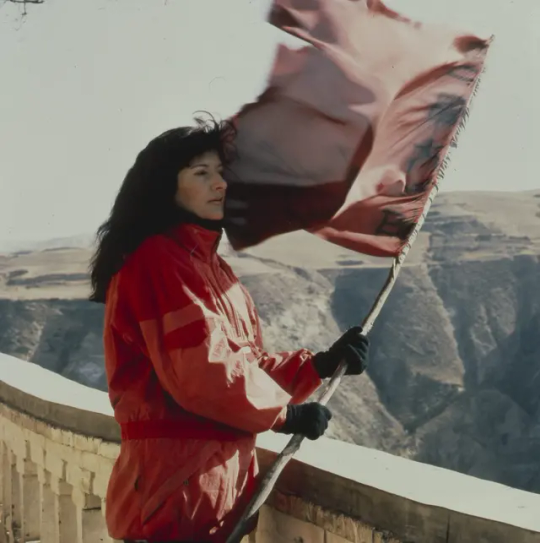
Marina Abramović, Great Wall Walk, China, Marina on the wall (1988). Photo courtesy of the artist.
“There were many different minerals that was in the ground. Each time I walk on that kind of minerals, I have the feeling different energy. I felt different,” Abramović said, noting that she encountered iron-rich hematite and red clay.
She doesn’t necessarily expect visitors to be in tune with the subtle effects of the minerals. The artist once watched a pair of Americans asking each other if they felt anything after 10 minutes with a crystal artwork. They agreed they didn’t, and decided to go get a hamburger.
“It’s very important to actually stay a long time with objects,” Abramović said. “If you want to get the muscles in gym, you don’t get muscles from one training. You get muscles by doing it every day.”

Marina Abramović, Great Wall Walk, China, Marina with people (1988). Photo courtesy of the artist.
The artist is especially excited about giving people the chance to train on sculptures she calls telepathy phones.
“Actually, it could take for anybody four years to learn telepathy, which is so much cheaper than using mobile phone. But nobody do, of course,” Abramović said.
Regardless of whether these pieces work in the way the artist claims, they represent a chance to leave behind works more lasting that an ephemeral performance.
“It’s not that I’m going to be able to perform when I’m 80, 90, 100, whatever,” Abramović admitted. “I have to find the system in which my mission and my legacy can go on. And this is exactly [what I do] with the ‘Transitory Objects.'”

Marina Abramović, Great Wall Walk, China, landscapes and portraits (1988). Courtesy of the artist.
The exhibition will also feature over 1,200 never-before-seen photographs of Abramović’s 1,550-mile journey to meet Ulay. It’s another reminder that decades later, the durational performance piece remains a formative experience for the artist.
“That was epic,” Abramović recalled. “I really fell in love with China.”
“Marina Abramović: Transforming Energy” will be on view at the Modern Art Museum Shanghai October 10, 2024–February 2025.
0 notes
Text
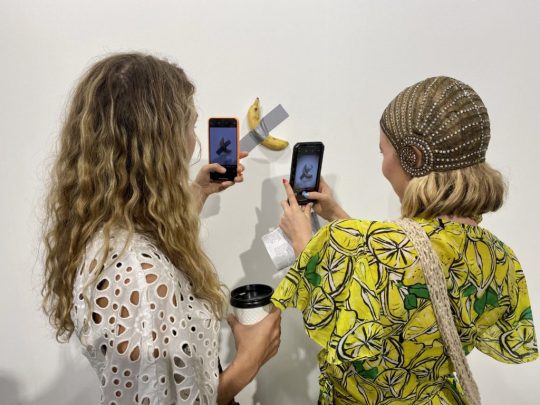
Maurizio Cattelan's Comedian, for sale from Perrotin at Art Basel Miami Beach. Photo by Sarah Cascone.
0 notes
Text

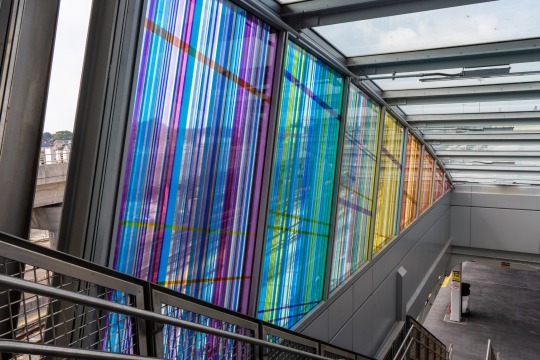

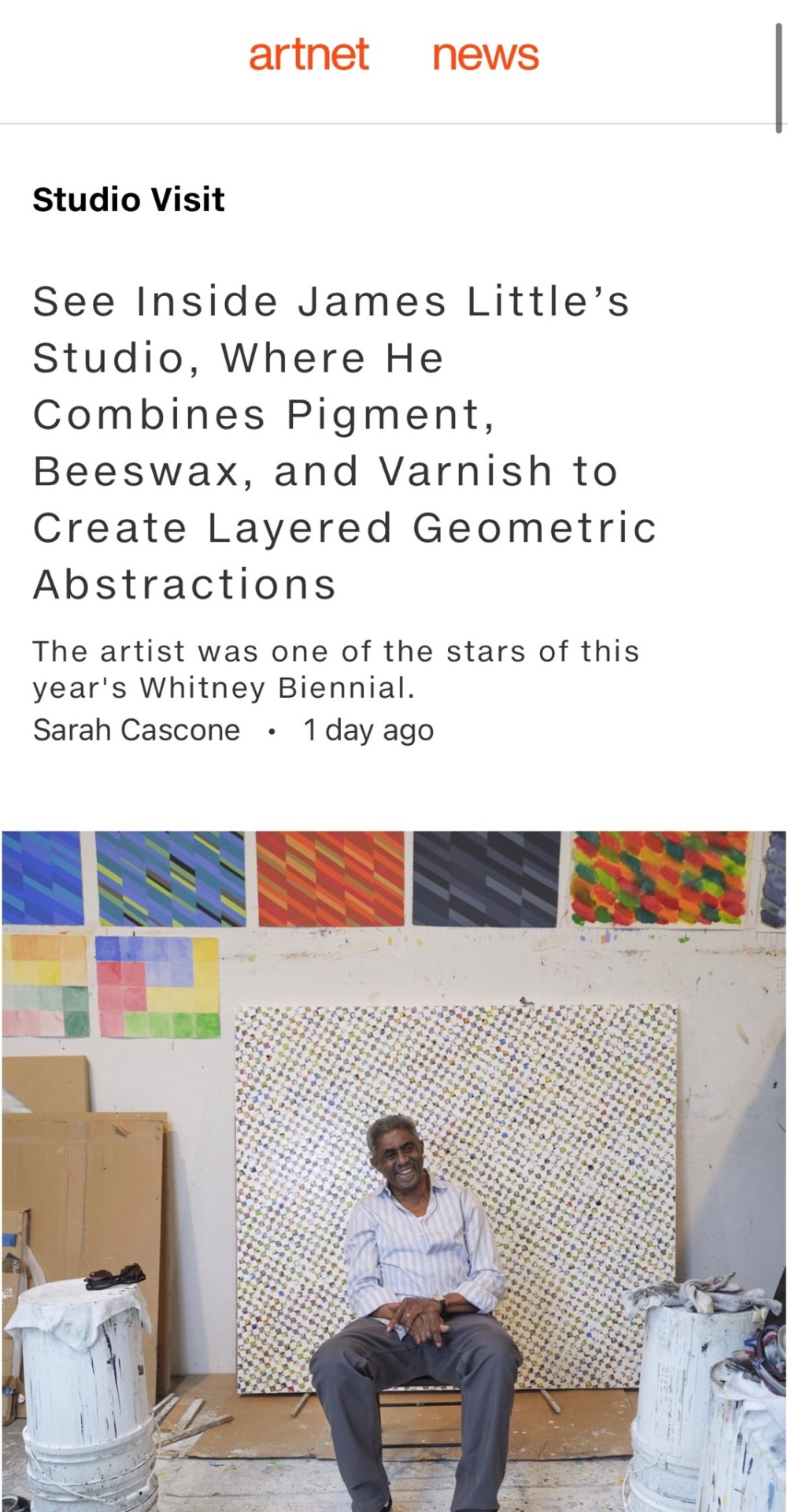
“Radiant Memories” (2020) James Little’s vibrant laminated glass artwork at LIRR Jamaica station, incorporates layers of colorful, intricate lines that together form flat, gradated blocks of color, creating a sense of movement and animation as the light shifts throughout the day. MTA Arts’ largest MTA LIRR installation to date brings a fresh aesthetic to the station and provides an immediate wayfinding signal to Brooklyn-bound commuters as they navigate their transfers.
James Little’s solo exhibition “Black Stars & White Paintings” is currently on view at Kavi Gupta in Chicago. In a recent studio visit, the artist told @artnet ’s Sarah Cascone: “In order to achieve simplicity, you have to understand a lot of complexities. My Black and White paintings both play with this idea – geometry and color each serve a very distinct purpose and, when integrated just right, you know it’s working.” Read the full article “See Inside James Little’s Studio, Where He Combines Pigment, Beeswax, and Varnish to Create Layered Geometric Abstractions” on Artnet News.
Photos: Sophia Little
24 notes
·
View notes
Quote
As her following grew, Qamar was tapped to create works for Indian celebrity chef Floyd Cardoz’s Bombay Bread Bar in New York and the set of The Mindy Project, the television series created by Indian American actor and writer Mindy Kaling. But Qamar still had to stage her own art exhibitions, finding locations and installing works for herself—until she heard from Taittinger. “It was the perfect time. I was at a point of my career where I really just wanted to paint and get that work out,” Qamar said. “This is an industry that’s hard to get into, especially for someone who hadn’t gone to art school and didn’t have any connections in the field. It seemed impossible for me to enter that space.”
Sarah Cascone, 'How Maria Qamar’s Feminist Desi Pop Art Went Viral on Instagram, Charmed Mindy Kaling, and Broke Into the New York Art World, artnet News
#artnet News#Sarah Cascone#Maria Qamar#Floyd Cardoz#Bombay Bread Bar#New York#The Mindy Project#Mindy Kaling#art exhibitions#Richard Taittinger#art industry#art school#connections
5 notes
·
View notes
Text
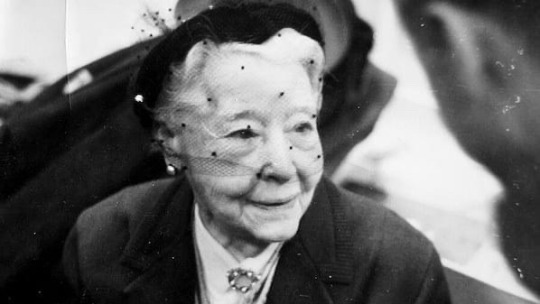

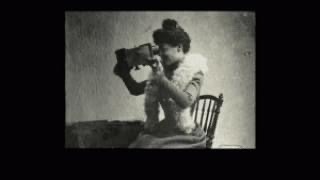

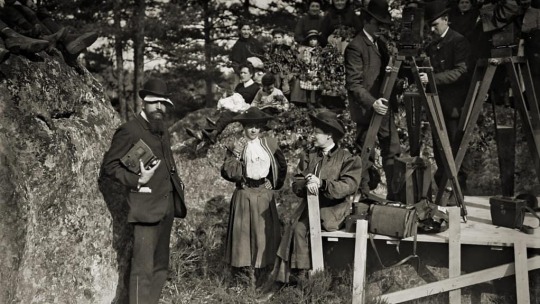


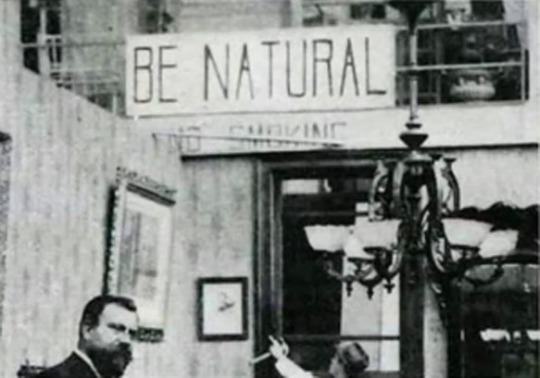
Alice Guy Blaché, 1873 - 1968 - Cinema Pioneer
Alice Ida Antoinette Guy-Blaché was a French #pioneerfilmmaker, active from the late 19th century, and one of the first to make a narrative fiction film.
She was the #firstwoman to direct a film.
From 1896 to 1906, she was probably the only #femalefilmmaker in the world. She experimented with Gaumont's Chronophone sync-sound system, and with color-tinting, interracial casting, and special effects.
She was artistic director and a co-founder of Solax Studios in Flushing, New York. In 1912, Solax invested $100,000 for a new studio in Fort Lee, New Jersey, the center of American filmmaking prior to the establishment of Hollywood.
That year, she made the film A Fool and His Money, probably the first to have an all-African-American cast.
The film is now at the National Center for Film and Video Preservation at the American Film Institute. Via Wikipedia
Born: Alice Ida Antoinette Guy, July 1, 1873, Saint-Mandé, Val-de-Marne, France
Died: March 24, 1968, Wayne, New Jersey, U.S
History’s First Female Filmmaker Has Been Rescued From Obscurity Thanks to an Enlightening New Jodie Foster-Narrated Documentary
Alice Guy-Blaché, the director of nearly 1,000 early films, created what may be the world's first narrative movie. By Sarah Cascone, August 20, 2019
Photo: Alice Guy-Blaché, La Fée aux choux (The Cabbage Fairy)(1900/1896), for Gaumont. Photo courtesy of Musée Gaumont, Paris.
Source: https://news.artnet.com/art-world/alice-guy-blache-pioneering-female-filmmaker-1629004
Watch also:
Be Natural: The Untold Story of Alice Guy-Blaché, directed by Pamela B. Green
https://benaturalthemovie.com/
#BeNatural #GuyBlaché #AliceGuyBlaché #pioneer #femalepioneer #PamelaBGreen #CinemaPioneer
#AliceGuyBlache
#FirstFemaleFilmmaker #JodieFoster #Documentary #herstory #artherstory #retrocinema #OldHollywood #historyofcinema
2 notes
·
View notes
Link
[Originally published October 2, 2018]
#MaryWeatherford: takes us on a tour of Mary Weatherford's "I've Seen Grey Whales Go By" at Gagosian West 24th Street, New York. In addition to a number of great installation shots, the article allows Weatherford to go into some detail about her working process and the perhaps unexpected narrative references that seemed to emerge as the exhibition came together: "Depending on how much water she uses, the paintings are essentially invisible to the artist as she is working, only emerging after the canvas has dried. 'Because the water reflects, I can’t really see what’s going to happen. It’s a quite a mystery,' Weatherford explained. 'As the water dries overnight and the pigment sinks into the painting, it’s like watching a photograph develop. I come in the next morning and the image is there.' .... Weatherford found that animals emerged as something of a recurring theme in this show. Upon closer examination, paintings that at first blush appear abstract reveal the suggestion of an eagle, a horse head, or the foot of a conch shell. 'The revelation in this exhibition is the figuration,' the artist said. 'There are many animals in this show. You might miss these on first glance.'"
http://fal.cn/VmjD
#Mary Weatherford#Weatherford#Gagosian#Gagosian Gallery#Gagosian West 24th Street#Chelsea#New York#Larry Gagosian#paintings#neon#art#exhibition#artnet#Sarah Cascone#contemporary art#I've Seen Gray Whales Go By#artist#news
5 notes
·
View notes
Photo

Sarah Cascone Gallery Visitor Onboard Red Grooms’ “The Bus” 1995
105 notes
·
View notes
Photo
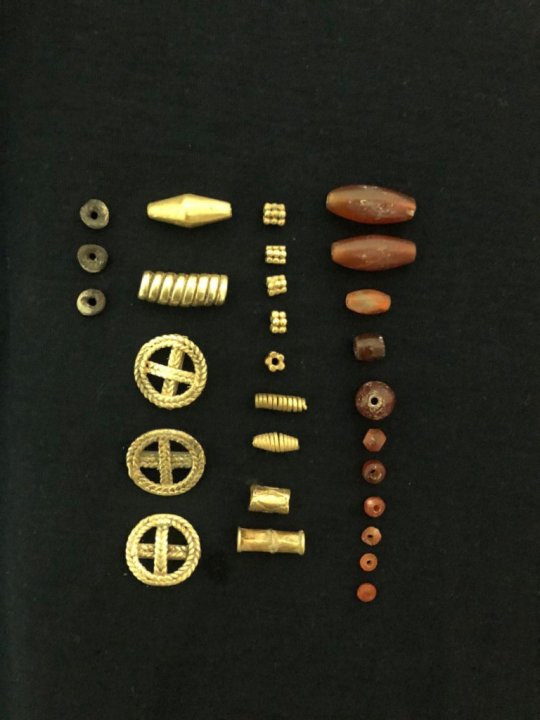


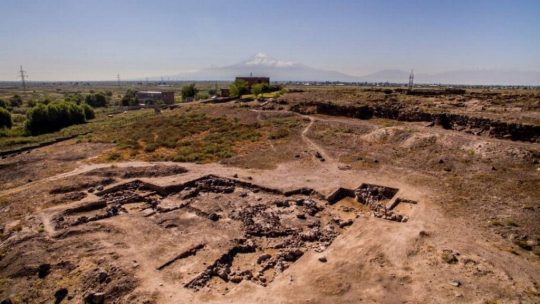
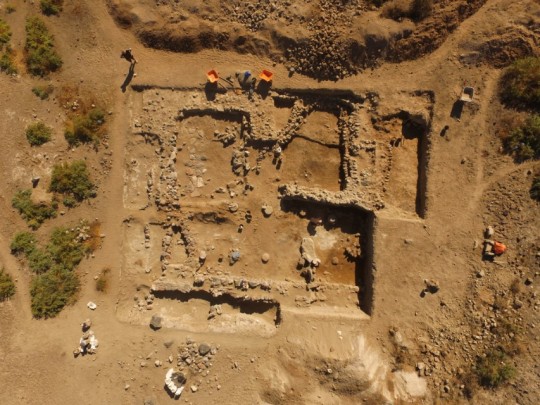




Archaeologists in Armenia Discover an Ancient ‘Golden Tomb’
It's the latest find from a joint Polish and Armenian excavation effort begun in 2013.
Archaeologists at Metsamor, an ancient necropolis in Armenia, have discovered a tomb filled with gold pendants and more than a hundred amber and carnelian beads. Dating to the late Bronze Age (1,300 to 1,200 B.C.E.), the grave also held the remains of a man and a woman, who appear to have be buried at the same time.
“Their death is a mystery to us, we do not know the cause, but everything indicates that they died at the same time, because there are no traces of tomb reopening,” Krzysztof Jakubiak, an archaeology professor at the University of Warsaw, said in a statement.
Laid to rest in an eternal embrace, the couple was buried in a cist, a stone-lined chamber dug into the ground. Believed to have died in their 30s, one wore bronze bracelets, the other a tin wire ring.
The grave also included a wooden burial bed, a faience flask, and about a dozen ceramic vessels. According to researchers, the beads and pendants were originally part of three necklaces, and the flask would have been imported from the Syrian-Mesopotamian borderland.
The research project at the Ararack Valley is a joint effort the Polish Center of Mediterranean Archaeology at the University of Warsaw and Armenia’s Service for the Protection of Historical Environment and Cultural Museum-Reserves, led by Jakubiak and Ashot Piliposian. The partnership has been ongoing since 2013, according to the Greek publication Archaeology; an exhibition of their findings opened last fall at the Armenian History Museum in nearby Yerevan.
To date, archaeologists have discovered about 100 graves in the cemetery, but the newly found golden tomb is one of the few that were not looted prior to the start of excavations in 1965. The cist graves would have been covered with burial mounds of earth that have eroded over the centuries.
Because the ancient Armenians do not appear to have been illiterate, and left behind no written records, archaeologists know little about Metsamor society. The walled settlement was at its height from 4th to the 2nd millennium B.C.E., with temple complexes surrounding a central fortress.
“It was a very large settlement. Even fortifications made of huge stone blocks have survived to our times, encircling the so-called citadel on the hill,” Jakubiak said. “There was no other settlement in the region that could be compared in terms of importance and size.”
By Sarah Cascone.
#Archaeologists in Armenia Discover an Ancient ‘Golden Tomb’#Metsamor#ancient tomn#ancient grave#ancient necropolis#ancient artifacts#archeology#archeolgst#gold#gold jewelry#history#history news#ancient history#ancient culture#ancient civilizations#bronze age
52 notes
·
View notes
Photo








Inside Meret Oppenheim's 'Otherworldly, Witty, Whimsical' Show at MoMA, the Swiss Surrealist's First U.S. Museum Retrospective in a Generation | Artnet News
Meret Oppenheim, 1982. Photo by Harry Croner.
Meret Oppenheim, Object (Objet [Le Déjeuner en Fourrure]) (1936). Photo courtesy of the Museum of Modern Art, New York.
Meret Oppenheim, Pair of Gloves (1985). Collection of the Kunstmuseum Bern, gift of Ruth von Büren. Courtesy of the Museum of Modern Art.
Meret Oppenheim, X-Ray of M.O.’s Skull (Röntgenaufnahme des Schädels M.O.), 1964/1981. Hermann and Margrit Rupf Foundation. Kunstmuseum Bern. Photo courtesy of the Museum of Modern Art, New York.
Installation view of “Meret Oppenheim: My Exhibition” on view at the Museum of Modern Art, New York. Her sculpture The Green Spectator (1959) blocks a doorway between galleries, a design choice envisioned by the artist in set of 1983 drawings for a possible retrospective of her work. Photo by Jonathan Muzikar, courtesy of the Museum of Modern Art, New York.
Meret Oppenheim, Red Head, Blue Body (1936). Collection of the Museum of Modern Art, New York, Meret Oppenheim Bequest. Photo by Sarah Cascone.
Meret Oppenheim, Stone Woman (1938). Photo by Sarah Cascone.
Meret Oppenheim, Ma Gouvernante (My Nurse), 1936. Collection of the Moderna Museet, Stockholm. Photo by Sarah Cascone.
If you know the name Meret Oppenheim, you probably associate the artist with one thing: fur. A new exhibition at the Museum of Modern Art, however, proves the Surrealist to be an artist of endless creativity and incredible versatility who drew, painted, and sculpted in a wide range of media and materials.
“She just had a remarkable imagination and unrivaled ability to get up in the morning and never do the same thing twice,” Anne Umland, the museum’s senior curator of painting and sculpture, told Artnet News. “It’s pretty radical that throughout her five-decade career, she managed to remain committed to a very otherworldly, witty, whimsical sensibility.”
The show, titled “Meret Oppenheim: My Exhibition,” is the artist’s first U.S. exhibition in 25 years, and it features numerous pieces that are being shown in the country for the first time. It originated at Switzerland’s Kunstmuseum Bern, which has the world’s largest holdings of the artist’s work, and is co-organized by the two museums and Houston’s Menil Collection. ...
37 notes
·
View notes
Text
The discovery of an impressive Greek tunnel under an ancient Egyptian temple (which perhaps is related to the tomb of Cleopatra)
I reblog this article about the discovery of an impressive tunnel of Greek style and engineering under an ancient Egyptian temple of the Hellenistic period. I don’t know whether it is really related to the tomb of Cleopatra VII Philopator, last Egyptian Pharaoh and Greek queen of Egypt. The future will show if the the expectations of the archaeologists who have done the excavation are founded or not, although I think that the discovery of the tunnel does not mean anything directly about the location of the tomb of the queen. But this discovery is itself very important, independently of the question of the tomb of Cleopatra. Moreover, the truth is that I would like to learn more about the function of this tunnel and its relation to the temple of Tapuziris Magna, questions which are also very important.
“An Ancient Tunnel Discovered Beneath an Egyptian Temple May Lead to Cleopatra’s Tomb, Archaeologists Say
For nearly 20 years, archaeologists have been searching the area around the temple Tapuziris Magna for the final resting place of the Egyptian queen and her husband Mark Antony.
Sarah Cascone, November 7, 2022

An alabaster statue of Cleopatra is shown to the press at the temple of Tasposiris Magna on the outskirts of Alexandria, on April 19, 2009. Archaeologists are now more convinced than ever that the tomb of Marc Anthony and Cleopatra lies nearby. Photo credit should read Cris Bouroncle/AFP via Getty Images.
Archaeologists have discovered a rock-cut tunnel beneath Egypt’s ancient Taposiris Magna Temple—and it may lead to the lost tomb of Cleopatra, who was the last ruler of Ptolemaic Egypt from 51 to 30 B.C.E.
The Egyptian Ministry of Tourism and Antiquities announced the find last week, describing the 4,265-foot tunnel, located 43 feet underground, as a “geometric miracle.” It is similar to the Tunnel of Eupalinos on the Greek Island of Samos, considered one antiquity’s engineering marvels.
News of the discovery, made during an excavation project led by archaeologist Kathleen Martinez of the University of San Domingo, was reported by Ancient Origins.
Cleopatra famously died by suicide after her husband, the Roman general Mark Antony, also killed himself. The two are believed to have been buried together.

The Greco-Roman tunnel archaeologists discovered beneath Tapuziris Magna Temple near Alexandria could be a sign that the lost tomb of Cleopatra and Mark Antony lies nearby. Photo courtesy of the Egyptian Ministry of Tourism.
Martinez first came to Egypt in search of Cleopatra’s tomb some 20 years ago, convinced after more than a decade of research that Taposiris Magna, located on outskirts of Alexandria and dedicated to Osiris, the god of the dead, was a leading candidate for the queen’s burial spot.
After hundreds of ignored emails, Martinez managed to secure a meeting in Cairo with archaeologist Zahi Hawass, then the country’s minister of Egypt’s antiquities affairs.
She convinced him to give her two months to conduct excavations on the site. Work has been ongoing since 2004—but the new find is the most compelling evidence to date that Martinez is on the right track.
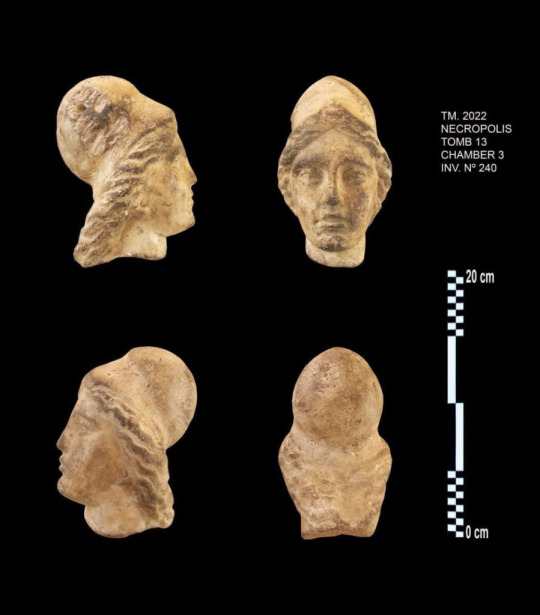
Archaeologists discovered this alabaster head at excavations beneath Tapuziris Magna Temple near Alexandria. Photo courtesy of the Egyptian Ministry of Tourism.
“This is the perfect place for the tomb of Cleopatra,” Martinez told the blog Heritage Key. “If there’s a one percent chance that the last queen of Egypt could be buried there, it is my duty to search for her. If we discover the tomb… it will be the most important discovery of the 21st century. If we do not discover the tomb… we made major discoveries here, inside the temple and outside the temple.”
To date, the excavations have revealed mummies with golden tongues and a cemetery containing Greco-Roman-style mummies buried facing the temple, which supports Martinez’s theory that a royal tomb was built in the area. There was also a bust believed to depict Cleopatra and 22 coins depicting her visage.
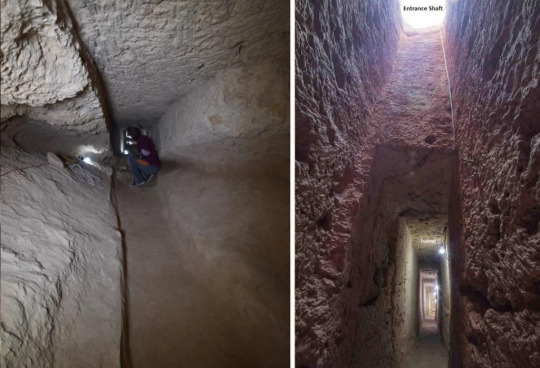
The Greco-Roman tunnel archaeologists discovered beneath Tapuziris Magna Temple near Alexandria could be a sign that the lost tomb of Cleopatra and Mark Antony lies nearby. Photo courtesy of the Egyptian Ministry of Tourism.
In addition to the tunnel, the latest find includes two Ptolemaic-era alabaster statues, one of which appears to be a sphinx, as well as ceramic vessels and pots. Part of the tunnel is underwater, perhaps due to ancient earthquakes that struck the region between 320 and 1303 C.E. Those natural disasters could have led to the collapse of the Taposiris Magna.
Egypt’s most famed archaeological discovery, of course, is King Tut’s tomb, unearthed 100 years ago last week by Howard Carter in the Valley of Kings outside the city of Luxor.
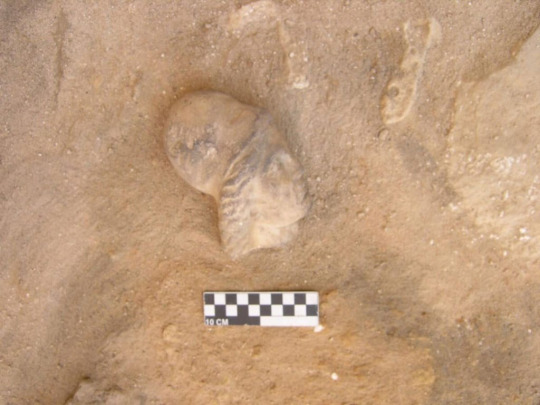
Archaeologists discovered this alabaster head at excavations beneath Tapuziris Magna Temple near Alexandria. Photo courtesy of the Egyptian Ministry of Tourism.
A century later, the site is still the subject of active, fruitful excavations—and debate, with scholars and experts divided on the possibility that the burial chamber contains hidden rooms.
British Egyptologist Nicholas Reeves has been a longstanding proponent of the theory that it was originally built as the tomb of Nefertiti, the boy king’s stepmother. (Hawass has separately claimed that he is on the verge of announcing the discovery of Nefertiti’s resting place.)
Source: https://news.artnet.com/art-world/archaeologists-tunnel-cleopatra-tomb-2205456

Kathleen Teresa Martínez Berry (born 1966) is a Dominican lawyer, archaeologist, and diplomat, best known for her work since 2005 in the search for the tomb of Cleopatra in the Taposiris Magna temple in Egypt. She heads the Egyptian-Dominican mission in Alexandria, and is currently minister counselor in charge of cultural affairs at the Dominican embassy in Egypt. Source: https://en.wikipedia.org/wiki/Kathleen_Mart%C3%ADnez
19 notes
·
View notes
Text
Get Your Art Fix!

"Tomorrow belongs to those who can hear it coming." ~ David Bowie
"Natural Villains" by Markus Klinko, 2002
Series: Bowie Unseen
Arty-Fact: On the strength of [his] work for David Bowie's "Heathen" album, Markus was asked to create the cover image for GQ‘s “Man of the Year” issue honoring David. The resulting image shows the rock star fearlessly posing with a pack of wild wolves. Due to David's busy schedule and lack of availability for another shoot, Markus was forced to use a body double with the wolves, carefully adding in the singer’s face from the photos taken for "Heathen" during post-production.
“Our male model proved himself quite brave, as he worked it with the energetic and sometimes aggressive wolves. While his face looked nothing like Bowie, he was able to channel him through his body language.” ~ Markus Klinko
Source: "Markus Klinko’s Amazing Never-Before-Seen Photos of David Bowie" by Sarah Cascone, ArtNet News, 2016

See It On Your Wall
2 notes
·
View notes